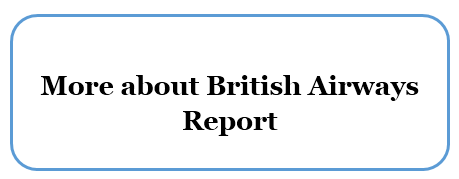British Airways Porter’s Five Forces Analysis
British Airways Porter’s Five forces analysis is an analytical framework developed by Michael Porter (1979)[1]. The framework distinguishes between five individual forces that shape the overall extent of competition in the industry and studies them. These forces are represented in Figure 1 below:
Figure 1 British Airways Porter’s Five Forces
Threat of substitute services for an airline is not significant. It has to be clarified that although there is a substitution for air travel, represented by other modes of transportation such as vehicles and sea transports, air travel remains as the fastest form of travel. From this point of view, it can be argued that there is no substitution to airplanes to travel thousands of miles in a matter of few hours.
At the same time, rapidly developing internet-based information and communication technologies represent indirect substitution for air travel. For example, an intensive development of communication technologies during the last decade presented the opportunities of real-life video conferencing, thus eliminating the necessity for long-distance travels for business and other meetings.
Threat of new entrants into the airline industry is low. Major capital requirements is one of the most significant barriers for new market entrants. As it is illustrated in Figure 2 below, the cost of Boeing aircrafts, one of the most popular airplane brands, can reach USD 400 million and there are no aircraft from reputable manufacturers with a price tag of less than USD 70 million.
Figure 2 Average prices for Boeing aircraft in 2015, by type (in million U.S. dollars)[2]
Lack of access to distribution channels represents another significant barrier for new market entrants into the airline since. This is because it may prove to be difficult to find free slots and runways in the major international airports such as Heathrow Airport in UK and JFK airport in New York City, USA. Moreover, there are challenging legal and regulatory barriers in the airline industry and the new market entrants are most likely to face retaliation from existing airlines such as British Airways, Virgin Atlantic airways Limited, Monarch Airlines.
Bargaining power of British Airways buyers is moderate. On one hand, a high level of intensity of competition in the industry and the absence of switching costs for consumers fuel their bargaining power. On the other hand, there is no feasible alternative for customers for transatlantic and long distance travel in short time apart from using the services of air carriers such as BA…
British Airways Report contains a full version of British Airways Five Forces Analysis. The report also illustrates the application of the major analytical strategic frameworks in business studies such as SWOT, PESTEL, Value Chain Analysis and McKinsey 7S Model on British Airways. Moreover, the report contains analysis of British Airways marketing strategy, discusses leadership and organizational structure and addresses the issues of corporate social responsibility.
[1] Porter, M. (1979) “How Competitive Forces Shape Strategy” Harvard Business Review
[2] Statista (2016) Available at: http://www.statista.com/statistics/273941/prices-of-boeing-aircraft-by-type/



